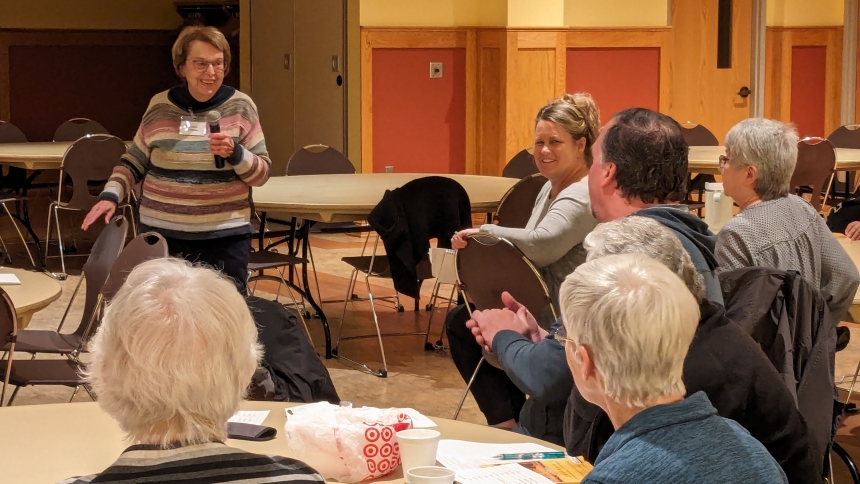
SCHERERVILLE – We’ve all heard of manna in the desert, but do we realize the literal connection to the Holy Eucharist? Do we know why Jesus instituted the Eucharist during the feast of Passover? And why does Jesus tell us to eat his body and drink his blood? The almost 40 people attending a program, “Jesus and the Jewish Roots of the Eucharist,” in St. Patrick Hall at St. Michael the Archangel, Schererville, are discovering answers to these questions and more.
Parishioner Bob Margala said prior to attending the program he had “an extremely limited understanding of the Old Testament concept of why we have to eat the sacrifice” and that he is “hoping this will improve my understanding of what the Eucharist is.”
At the first session on Feb. 5, Margala was inspired by parallels drawn between the Old Testament and New Testament, and curious about the loss of context and understanding that modern Bible readers have about the culture during Jesus’ life on earth.
“By improving my understanding of where the sacrifice of the Eucharist comes from, I hope to improve my own quality and depth of spiritual experience when I receive the Holy Sacrifice,” Margala said. “I also want (my wife) Jill to get as much exposure to learning about the Eucharist as possible, because I pray that someday she will come to Jesus and accept him in the Holy Sacrament of Communion.”
St. Michael’s Adult Education Ministry sponsored this event that meets each Monday until April 8 and encourages participants to delve deeper into understanding the Holy Eucharist. “We wanted to do something to prepare for the National Eucharistic Congress Revival, and we also wanted to use FORMED,” said Cathy Bartczak, a member of the Adult Education Ministry. The result was a series called Lectio Eucharist found on FORMED that is based on the book, “Jesus and the Jewish Roots of the Eucharist,” by Brant Pitre, who has a doctorate in New Testament and ancient Judaism.
As a presenter in the video, Pitre answers questions such as: What was the Passover like at the time of Jesus? What were the Jewish hopes for the Messiah? What was Jesus' purpose in instituting the Eucharist during the feast of Passover? And, what did Jesus mean when he said, "This is my body… This is my blood?”
St. Michael Pastoral Associate Janice Gatons said answers to these questions are inspiring for participants. “There is so much to learn,” she said. “This is inspiring and informative, even groundbreaking. We are having a lot of conversations about things that we’ve never really thought of before. It’s very, very interesting.”
Gatons said in addition to preparing for the National Eucharistic Congress in Indianapolis, this program helps prepare for Easter. During Lent we concentrate on the life of Jesus and the importance of understanding that he is the sacrifice – how Jesus united the Last Supper to his death on Good Friday and his Resurrection on Easter Sunday – and how we can show our love to him, she explained.
Bartczak is excited that the participants are gaining a better understanding of occurrences in the Old Testament as precursors to the life of Jesus and how they relate to the Mass and the true presence of Christ in the Eucharist. “Even though the word Mass is not mentioned in the Bible, they will see how the Eucharist is hidden in the pages of scripture and the Mass is the most visible sign of what it is meant to be Catholic as it unites us as we come together on Sunday to receive the Eucharist,” Bartczak said.
Deacon Joe Stodola, of St. Thomas More, Munster, is enjoying the program. “During our small group, we discussed that Eucharist is who we are and what we’re about. Ask yourself why are you coming; what are you there for, the Eucharist. It’s what we believe.”
Margala, who revels in the parallels between the early Jewish tradition of Passover and Jesus’ crucifixion, was inspired to look ahead. He found that in the tradition of Passover, Ancient Jews sacrificed unblemished male lambs in the temple, placed them on skewers, and paraded them out of town. The sacrifices generated gallons of blood which were washed out through the side of the temple with water. Jews at that time would have had those images in mind during the crucifixion of Jesus, who called himself the new temple, and whose side was pierced – gushing blood and water. “I find myself asking why didn’t I know any of this before.”
Caption: St. Michael Pastoral Associate Janice Gatons responds to a question on Feb. 5, during a parish program inspired by a series called Lectio Eucharist found on FORMED that is based on the book, “Jesus and the Jewish Roots of the Eucharist." After watching videos, participants had small and large group discussions in St. Patrick's hall of the parish. (Lynda Hemmerling photo)


